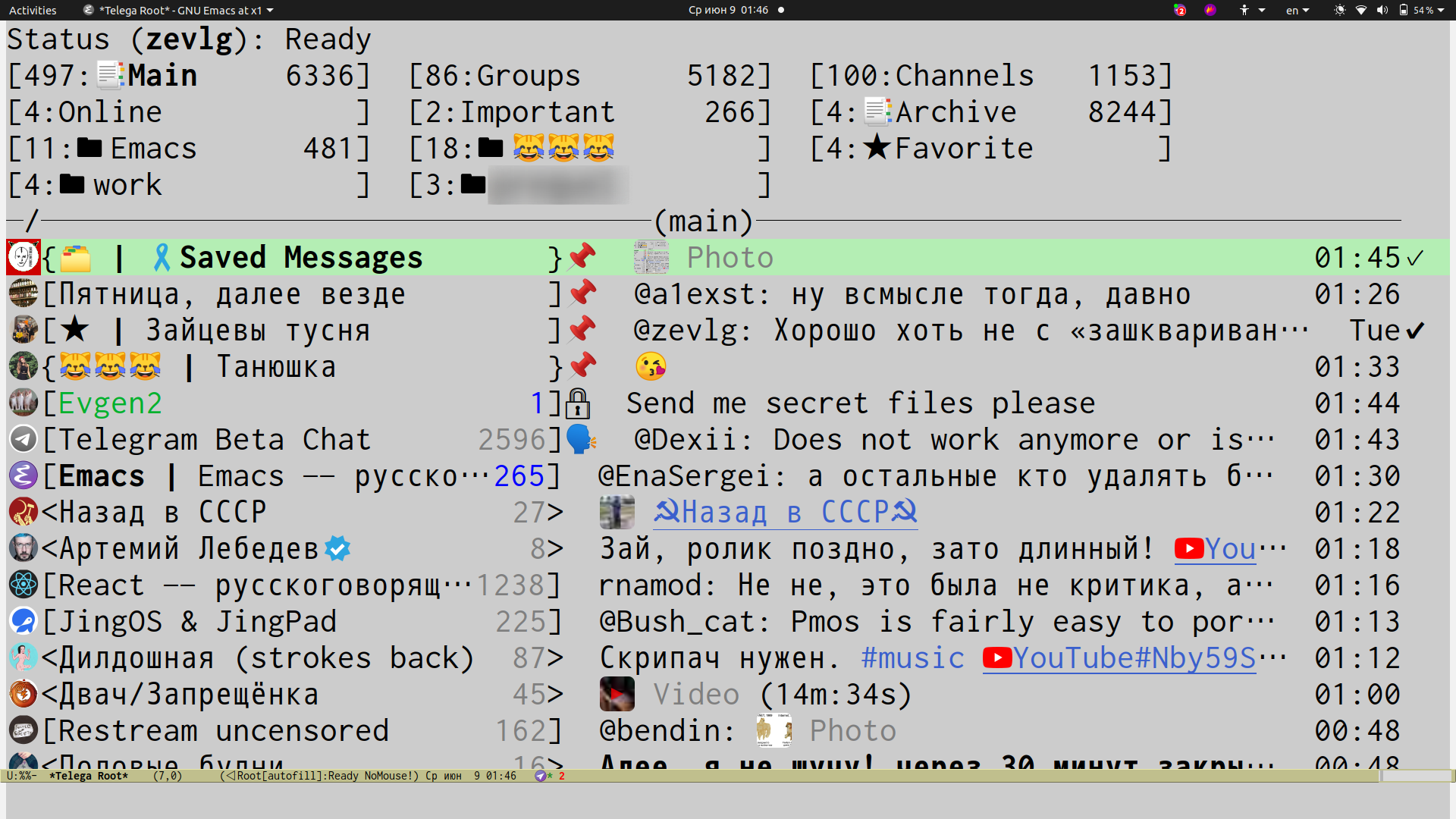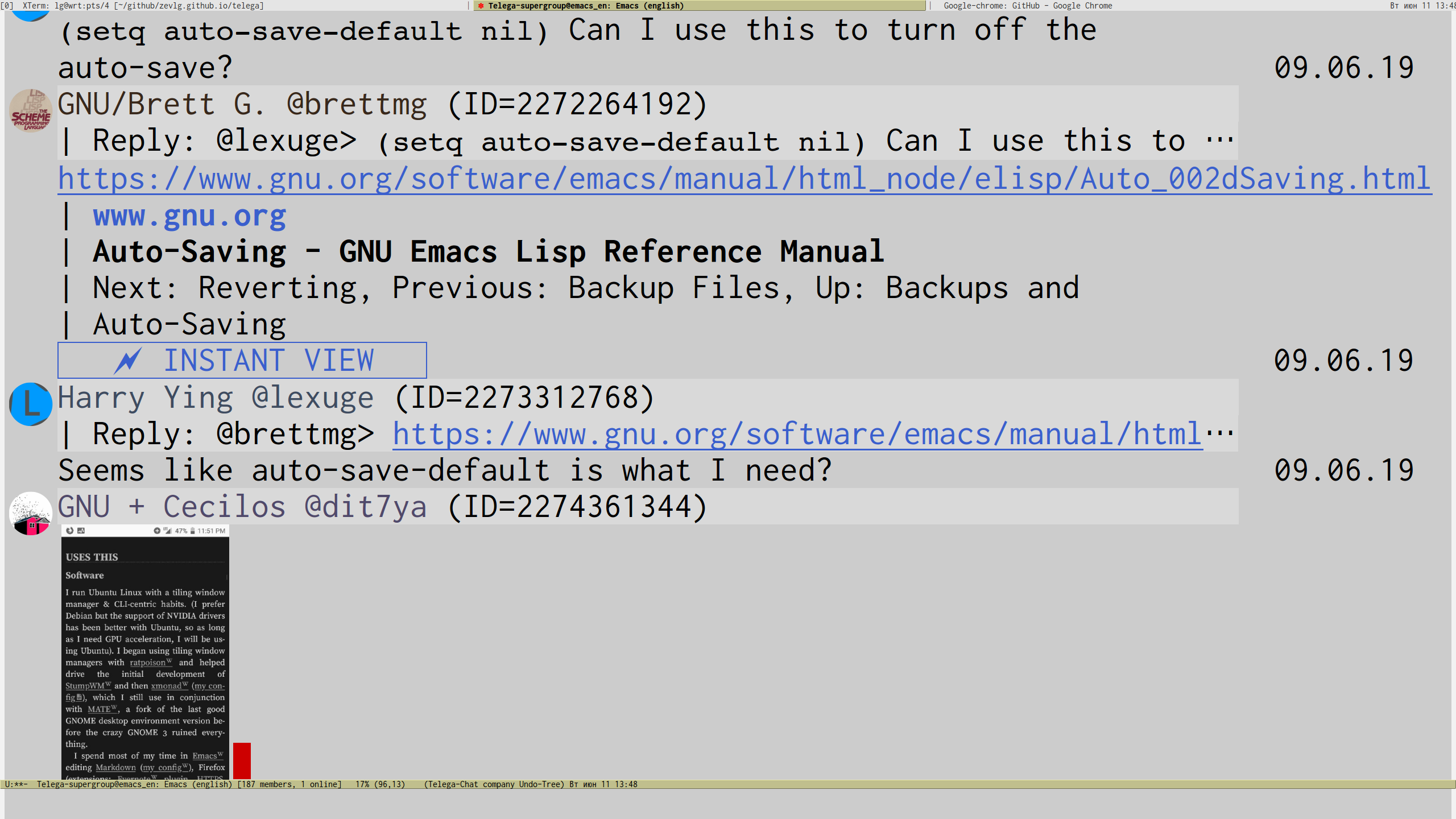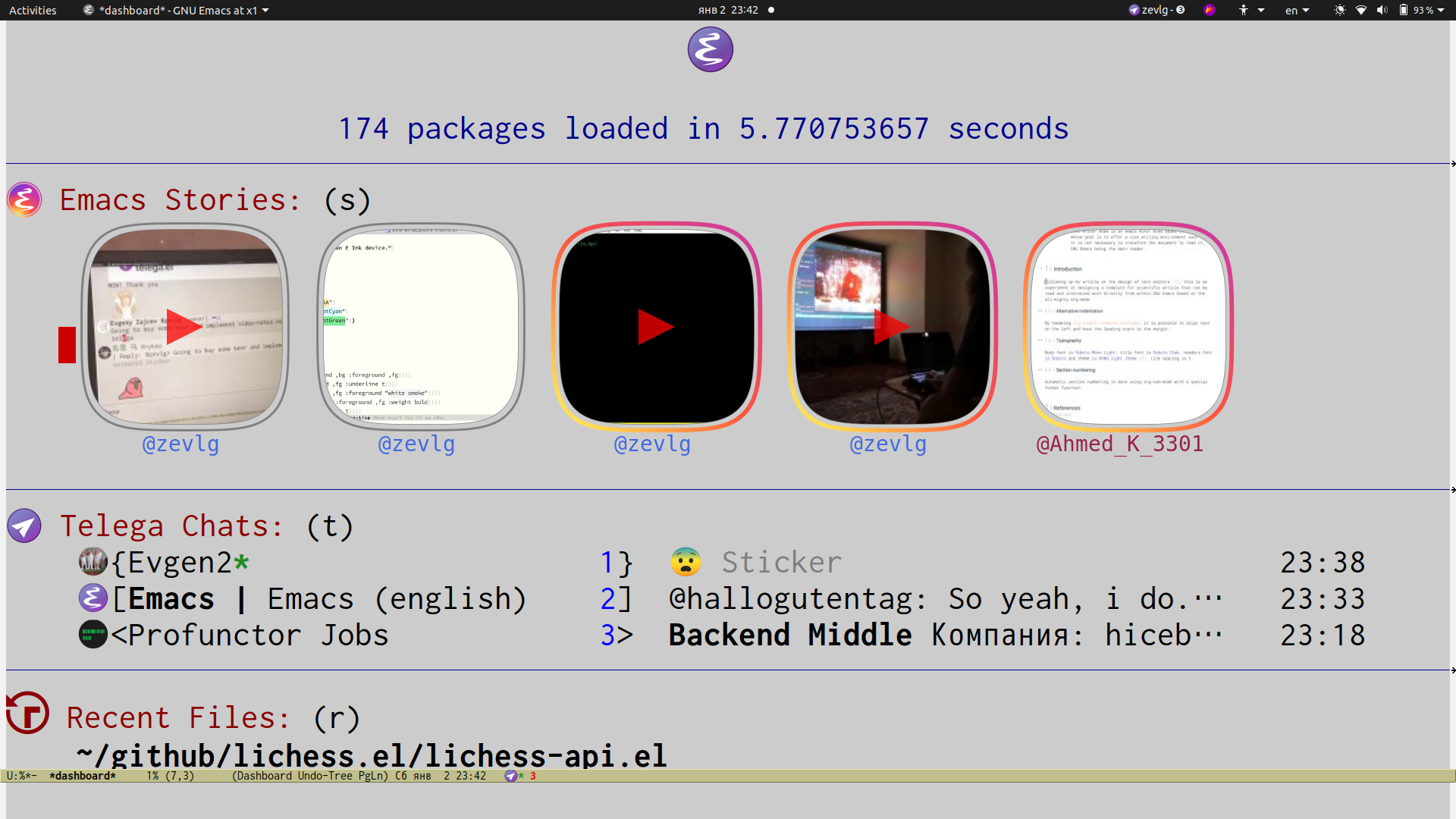See Telega Manual for comprehensive documentation.
This project is developed on two primary branches. The 'releases' branch is kept in compatibility with TDLib major releases. The 'master' branch is for developmental purposes, and utilizes unstable features in TDLib.
telega.el is full featured unofficial client for
Telegram platform for GNU
Emacs.
telega.el is actively developed, for this reason, some features are
not implemented, or they are present just as skeleton for future
implementation. However, the core parts are mature enough so that it
is possible to use telega.el for basic chat.
In some random order:
- Listing chats, reordering chats according to internal Telegram order
- Getting info about users, groups and supergroups
- Joining chats by invitation link
M-x telega-chat-join-by-link RET - Fetching chat history, sending messages, replies, edits, deleting
- Resend failed messages
- Creating new groups, upgrading basicgroup to supergroup
- Forwarding messages
- D-Bus notifications on incoming messages in chats with enabled notifications
- Voice/Video calls
- Downloading files from the cloud
- Uploading files/media (also pasting images from clipboard) to the cloud
- Display chat actions, such as "@user is typing..."
- Display/Update chat's draft message
- Company backends for emoji (
:<emoji>syntax), usernames, hashtags, bot commands completions - Secret chats
- Online global searching chats/contacts/messages
- Avatars, Photos, Stickers, Animated Stickers
- Animated GIF, via ffplay
- Special messages such as location/live location, voice/video messages, contacts, self-destruct photo/video, etc
- Poll messages, Poll creation
- Games, Game Scores
- Handling local links, such as "tg:" or "https://t.me/xxx"
- ReplyMarkup (inline keyboard buttons) in the messages
- InstantView for web pages
- Blocking/Unblocking users, listing blocked users
- Inline bots requests, via "@bot query"
- Chat Lists, "Archived Chats", see telega#100
- Searching for messages in chat (PARTLY)
- Shared media
- Multiple accounts
- Traffic control, see telega#62
- TranslationsPlatform support (PARTLY)
- Message scheduling, Reminders
- Cloud themes, see TDLib#691
- Telegram Folders (since TDLib 1.6.6)
- Disable/Enable message notification on receiver side
- Sticker Outlines (since TDLib 1.7.X+), see Emacs Story - https://t.me/emacs_stories/73
- Voice Chats (since TDLib 1.7.X+)
- Expressive
ibuffer-like chats filtering - Powerful chats sorting
- Custom order for chats (some chats on top, some chats on bottom, etc)
- Client side messages filtering
- Get diff for the message edits, see screenshot
- Messages squashing minor mode.
- Highlight code blocks minor mode.
- Emacs Stories - share your Emacs experience with other Emacs users.
- AdBlock - block advertisement messages in Telegram channels.
And much more.
Root buffer screen:
Chat in @emacs_en group:
Dashboard with Emacs Stories and important chats:
See Telega Manual for comprehensive documentation.
Join our Telegram group
to discuss the development of telega.el.
Submitting issues is exceptionally helpful.
telega.el is licensed under GNU GPL version 3.
Q: I have this error while installing telega
Cannot open load file: No such file or directory, visual-fill-columnA: telega.el depends on the visual-fill-column package, please
install it first. This package is available from
MELPA
Q: I have this error while running telega
(error "Invalid image type ‘svg’")and/or
(error "Invalid image type ‘imagemagick’")A: The appropriate behavior is adjusted based on what version of
Emacs you use. If you are using 26.3 or older you need to ensure that
your Emacs was configured with SVG and ImageMagick support. SVG support
is provided using the librsvg library, and ImageMagick is provided by
libmagickcore and libmagickwand development libraries.
If you are using Emacs 27.1+ the ImageMagick support was deprecated as
it posed a significant security issue, but telega now relies on the
in-built (and faster) image-transforms for those versions.
Q: Does telega have proxy support?
A: Yes, use telega-proxies custom variable, for example:
(setq telega-proxies
(list
'(:server "1.2.3.4" :port 8080 :enable :false
:type (:@type "proxyTypeSocks5"
:username "rkn" :password "jopa"))
'(:server "2.3.4.5" :port 8088 :enable t
:type (:@type "proxyTypeSocks5"
:username "rkn" :password "jopa"))
))See C-h v telega-proxies RET for full range of proxy types.
Q: Stickers are not shown.
A: If you are using Emacs 26.3 or older, ensure you it was
configured with ImageMagick support. Next, install the webp package.
Q: There are no glyphs for some unicode characters.
A: Please either install fonts-symbola package, or run
guix package -i font-gnu-{freefont,unifont} on GNU Guix
If using fonts-symbola, add this to your init.el:
(set-fontset-font t 'unicode "Symbola" nil 'append)Q: There is some formatting issues when some unicode characters are used.
A: Yes, partly. If character has full width of multiple ordinary chars
you can tweak char-width-table. Add code like this to your init.el:
(setq telega-symbol-unread "🄌")
(defun my-telega-load ()
;; 🄌 occupies two full chars, but (string-width "🄌") returns 1
;; so we install custom widths to `char-width-table'
(telega-symbol-set-width telega-symbol-unread 2)
;; ... other code
)
(add-hook 'telega-load-hook 'my-telega-load)There is also telega-symbol-widths custom variable, you might want
to modify it.
Q: Is there erc-like chats tracking functionality?
A: Yes, set telega-use-tracking-for to non-nil
Tracking is done only for opened chats, i.e. chats having corresponding chat buffer.
Its value is a Chat Filter.
For example, to enable tracking for chats with enabled notifications or for chats where you have unread mention, use:
(setq telega-use-tracking-for '(or unmuted mention))Q: Is it possible to use telega in tty-only Emacs (aka emacs-nox)?
A: Yes, set telega-use-images to nil before starting telega
Q: Is it possible to add markup to messages?
A: Yes, use C-u RET to send a message with markup
See Sending ordinary messages for details
You may also find telega-mnz.el from the contrib directory to be
complimentary.
Q: I've enabled telega-notifications-mode, but notifications
does not show
A: Make sure your time is correct
Eval (telega-time-seconds) to get UTC time in your Emacs,
it should be more or less the same as on https://www.unixtimestamp.com/





